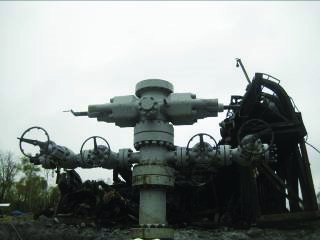Case Study Overview
This subject well was drilling at a depth of 11,050’, when the well started flowing. The well was shut in by closing the annular BOP. However, the pop off valve on the mud pump gave up and the flow from the well continued.

Situation Upon Arrival
CWC personnel were passing from near the location when they observed a massive gas discharge on the interstate passing near the rig CWC personnel arrived on location and discussed the situation with company representatives on location. While CWC personnel were preparing for access to the rig to shut down the rig’s generators and close the TIW or standpipe valve, the rig caught fire due to unknown reasons. The well was blowing from the 9 ⅝” x 5” annulus and also through the 5” drillpipe with a flame ±70’ high. A 55 mile stretch of the interstate was closed due to the fire.
Intervention Strategy
The forward plan included building a staging area near the well, removing the debris around the well, skidding the rig and then capping the well.
Operations
The location was prepared for the intervention process. A staging area was constructed and CWC firefighting system was rigged up.
The debris around the well were removed and hauled away from the location. Once all the debris around the rig was removed, preparations to skid the rig were started. A dead man anchor consisting of 20 stands of 5” drillpipe was buried ±30’ under the ground, at a distance of ±60’ from the rig. Also, plates were welded to the I beams on the substructure to make them more stable. The dead man anchor was connected via cables to the anchor block. A pull bridle was connected to the traveling blocks and the dead man and the traveling block were strung together.
A cut was made on the BOP stack below the lower rams, and above the DSA using a Dual Abrasive Jet Cutter. The rig was skidded by pulling the fast line coming off the traveling blocks with a bulldozer. While skidding the rig there was a sudden increase of flow from the well which lasted for approximately an hour.
The flow from the well had diminished while skidding the rig. It was unknown if the well was partially bridged or depleted. The fire from the well was put off and the old casing spool removed. The 5” drillpipe was cut ±60 ¾” above the 13 ⅝” casing head flange and a new 13 ⅝” 5M x 11” 10M casing spool was installed. The well was capped using a 13 ⅝” 10M single ram capping stack. A choke manifold was connected and a 3 ½” flare line was installed. The blind rams were closed and the well was diverted through the flare line. The flare line was ignited and the well was successfully capped and diverted.

A snubbing unit was rigged up to fish out the drillpipe and kill the well. However, since the fishing operations were unsuccessful, it was decided to rig up a coiled tubing unit. An attempt to kill the well was made by pumping 16.1 ppg mud down the annulus. However, the annulus was full after pumping a total of 310 bbl, probably indicating that the well was bridged.
The operator at this time decided to P & A the well. Cast Iron Bridge plugs were set and the well was cemented.